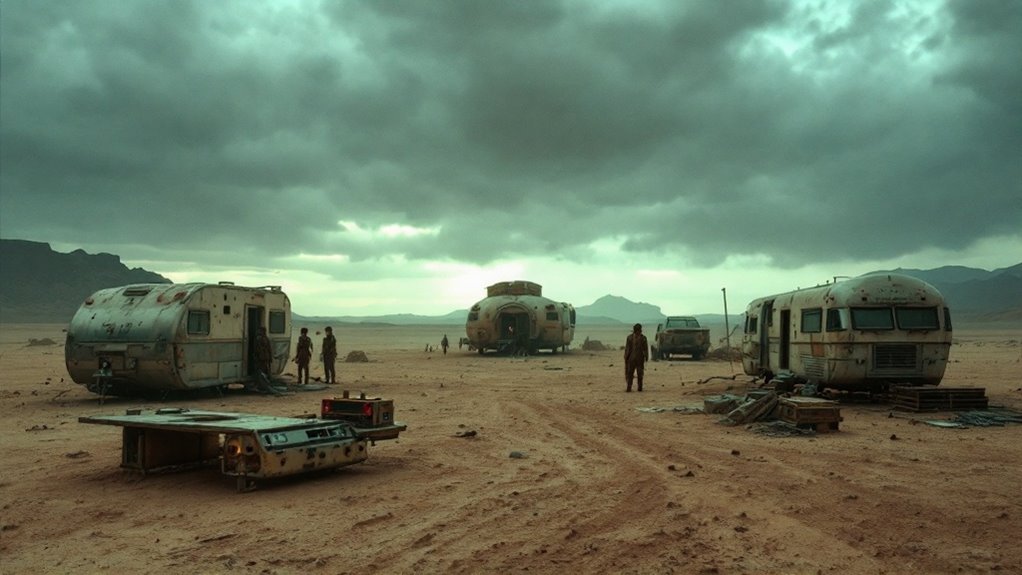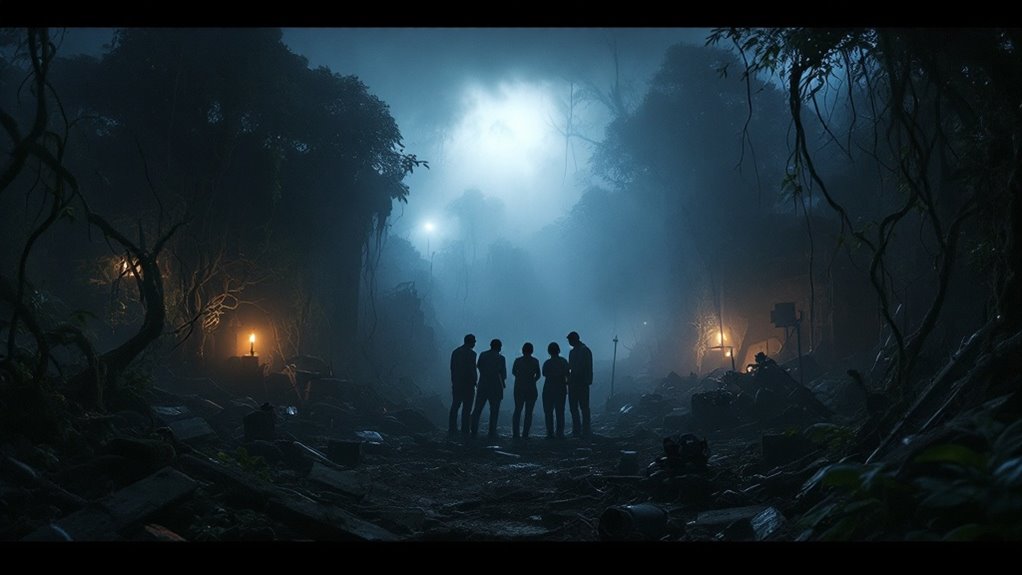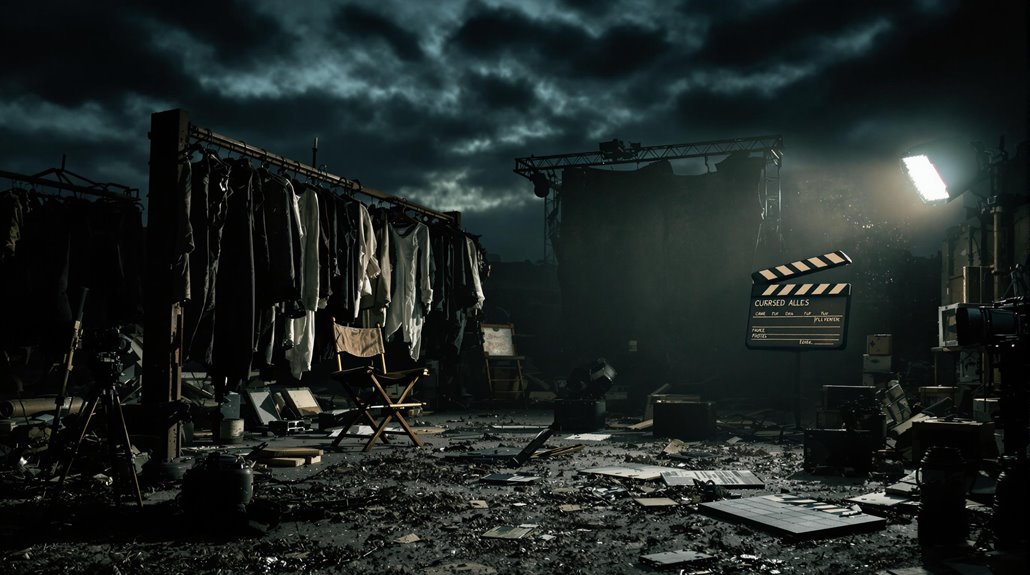You’re about to explore the unsettling world of cursed film sets, where blockbuster movies like The Exorcist and Poltergeist have witnessed more than just on-screen horror. These productions weren’t just plagued by technical mishaps but by eerily tragic events that left a lasting mark on Hollywood. Have you ever wondered what happens when ambition collides with the inexplicable?
From untimely deaths to bizarre coincidences, each of these stories raises questions about the thin line between fiction and reality. What’s lurking in the shadows of these famous films? Let’s uncover the mysteries together.
The Exorcist’s Haunting Incidents
How did a film set become a breeding ground for so many unsettling events? The Exorcist,”infamous for its chilling storyline, was plagued by incidents that blurred the line between fiction and reality. Envision this: a bird flies into a circuit box, igniting a fire that ravages the MacNeil home set. Oddly enough, Regan’s bedroom stayed untouched, like it had some otherworldly protection. The fire delayed filming for a whopping six weeks, leaving everyone wondering if the movie itself was possessed.
As if a set fire wasn’t enough, the cast injuries added another eerie layer to the production. Ellen Burstyn endured a permanent spinal injury during a scene, while Linda Blair fractured her lower back, leading to scoliosis and chronic pain. These injuries weren’t your regular bumps and bruises; they left long-lasting scars. Multiple deaths associated with the film’s production added to the sense of a curse, with people feeling an ominous presence on set.
The spooky vibe didn’t stop there. A crew member lost his toe, and a carpenter found himself minus a thumb. Even Max von Sydow faced tragedy with a family death. It’s like the set was cursed, with mishaps and misfortunes lurking at every corner. You’d almost expect a priest to walk through and perform an exorcism!
Twilight Zone’s Fatal Crash
Conceive the chaos and horror that unfolded on July 23, 1982, during the filming of a segment for Twilight Zone: The Movie. A tragic accident occurred when a Bell UH-1 Iroquois helicopter crashed, killing actor Vic Morrow and two child actors, My-Ca Le and Renee Chen. As you contemplate the scene, think about the intense pyrotechnic fireballs, intended to simulate a war-torn Vietnamese village. They instead caused the helicopter to crash, turning a Hollywood set into a nightmare.
Film safety seemed like an afterthought that tragic night. The production violated child labor laws by filming at 2 a.m. and ignoring warnings about the dangerous conditions. The helicopter flew perilously low, and the pilot, Dorcey Wingo, experienced abnormal vibrations during explosives tests but was discouraged from reporting them. This incident highlighted a culture of fear on set, where subordinates were hesitant to challenge director John Landis’s decisions. It’s a reminder that sometimes the pursuit of cinematic magic can overshadow common sense—something akin to building a house of cards on a windy day.
In the legal aftermath, director John Landis and others faced manslaughter charges but were acquitted. However, the tragedy led to stricter film safety regulations, ensuring that such a catastrophe wouldn’t easily repeat itself.
The Conqueror’s Radiation Exposure

The haunting legacy of Twilight Zone: The Movie reminds you that film sets can become deadly when safety is overlooked. But few tales of cinema tragedy linger like The Conqueror’s”radiation legacy. Imagine this: a film crew heads to Utah, blissfully unaware they’re downwind from the Nevada Test Site, where 11 nuclear tests had just occurred. The landscape, painted with invisible fallout, became a silent villain in this Hollywood saga.
You’d think the government’s assurances of safety would ease concerns, but the health impact was staggering. Of 220 crew members, 91 developed cancer, and 46 succumbed to it—including icons like John Wayne and Agnes Moorehead. Even the sand used for interior scenes was irradiated, adding to the exposure. It was producer Howard Hughes who, through eccentric production choices, transported 60 tons of irradiated sand to the studio, unwittingly increasing the crew’s radiation exposure. You can’t help but feel a chill thinking about the irony of bringing a desert into a studio.
While some argue high smoking rates contributed to the cancer cases, Moorehead’s diagnosis, despite being a non-smoker, suggests a more sinister culprit: radiation. The documentary The Conqueror: Hollywood Fallout sheds light on this tragedy, highlighting the fight for compensation by the “downwinder” community in Utah. It’s a poignant reminder of the importance of accountability and safety in filmmaking.
The Omen’s Eerie Coincidences
Few films have a reputation as unsettling as The Omen, where a series of eerie coincidences seem to weave a web of dread around its production. Envision boarding a flight and lightning striking your plane—not once, not twice, but three times! This bizarre chain of lightning incidents hit Gregory Peck, Mace Neufeld, and David Seltzer’s flights.
If that’s not enough to give you goosebumps, consider that Harvey Bernhard narrowly avoided a lightning strike in Rome. It’s like nature itself was trying to send a message. Adding to the eerie atmosphere, a rottweiler attacked a stuntperson on set, reinforcing the film’s reputation for unsettling events.
Then there were the animals. Filming at Windsor Wild Safari Park, the crew witnessed animals behaving in ways that were downright chilling. Lions and baboons acted violently, with baboons causing genuine panic during a scene. You can picture actors trapped in a car, unable to escape, as chaos erupted around them. It sounds like a horror movie within a horror movie!
Add to this the odd accidents and mirrored tragedies, and “The Omen” seems like more than just a film—it’s a magnet for the bizarre. It’s these spine-tingling tales that have cemented its legacy as one of the most cursed productions in cinematic history.
Poltergeist’s Tragic Losses
Exploring the tragic losses linked to the Poltergeist series unravels a fabric of eerie coincidences and real-life horrors that mirror its chilling narrative. You can’t help but wonder if the poltergeist fatalities were part of the alleged curse hovering over this production. Dominique Dunne’s murder by her ex-boyfriend shortly after the first film’s release set a dark precedent. Heather O’Rourke, the child star with the iconic line “They’re here,” succumbed to a misdiagnosed intestinal issue at only 12. It’s enough to give anyone goosebumps.
Add to that Julian Beck’s stomach cancer, Will Sampson’s post-surgery complications, and Lou Perryman’s tragic murder, and you start questioning the line between fiction and reality. Was it simply a series of unfortunate events or something more sinister?
The use of real human skeletons as props certainly didn’t help, adding fuel to the cursed productions theory. JoBeth Williams, unaware of this creepy cost-saving measure, had quite a shock post-filming. Even Will Sampson attempted an exorcism to cleanse the set of bad vibes, which, let’s be honest, sounds like a plot twist worthy of its own horror movie. Despite everything, the *Poltergeist* franchise remains a haunting part of cinematic history that captivates audiences and inspires cautionary tales.
Roar’s Wild Animal Chaos
Steering through the chaos of Roar‘s production reveals a film set engulfed in wild animal mayhem, creating an atmosphere of constant danger and unpredictability. Envision stepping onto a set where animal safety is a distant dream, and filming setbacks become the norm.
The ambitious shoot took place at Africa USA, now the Shambala big-cat preserve, where monsoon rains unleashed a 10-foot flood, destroying the set and causing $3 million in damages. Wildfires and mysterious diseases ravaged the animal population, as if Mother Nature herself objected to the mayhem. Despite the hazards, the filmmakers aimed to raise awareness about the plight of big cats, reflecting their deep commitment to animal welfare.
Injuries were as common as craft services. Up to 70 crew members suffered, with Melanie Griffith enduring a lion’s swipe to the face, requiring over 50 stitches. Jan de Bont, the cinematographer, was scalped, needing 220 stitches—a hair-raising story, literally. Even Tippi Hedren wasn’t spared, sustaining a fractured leg and bites from lions. Yet, amidst these calamities, the film’s photography persisted, often improvised, capturing chaotic scenes with up to 8 cameras rolling simultaneously.
Despite the $17 million budget, the film grossed a mere $2 million, cementing its legacy as a cautionary tale about the perils of mixing wild animals with Hollywood dreams.
Werner Herzog’s Perilous Productions

While Roar highlighted the chaos of working with wild animals, Werner Herzog’s productions demonstrate a different kind of madness in filmmaking. Imagine this: you’re in the Amazon jungle, surrounded by towering trees and the relentless buzz of insects. You’re part of Herzog’s visionary filmmaking, where jungle challenges become your daily reality. The epic Fitzcarraldo took nearly five years to film, plagued by setbacks like lead actor Jason Robards bowing out due to amoebic dysentery. Mick Jagger, cast as a sidekick, also had to leave, opening the door for Klaus Kinski’s unforgettable entrance.
Herzog’s insistence on authenticity led to the iconic scene where hundreds of native Indians pulled a 320-ton steamship over a mountain—no special effects, just pure grit. It mirrored the real-life exploits of Carlos Fermin Fitzcarrald, blending history with Herzog’s thematic flair. Classical music played amidst the Amazon’s wild beauty, contrasting sharply with its harsh environment. In a deleted scene from *Burden of Dreams*, Herzog’s interactions with Klaus Kinski offer additional insight into their volatile yet productive collaboration.
In *Burden of Dreams*, Les Blank captures Herzog’s indomitable spirit, shedding light on his “madman genius” reputation. Watching it, you can’t help but marvel at Herzog’s pursuit of “ecstatic truth” through sheer determination, even if it borders on madness.
Wrapping up
You’ve just journeyed through the eerie tales of cursed film sets, where ambition meets danger in unexpected ways. Did you know that Roar involved over 150 wild animals, leading to over 70 cast and crew injuries? It’s like a zoo run amok! These stories remind you that the world of filmmaking isn’t just glitz and glamour; it’s an unpredictable adventure. So next time you watch a blockbuster, remember the wild tales that might be lurking behind the scenes.




